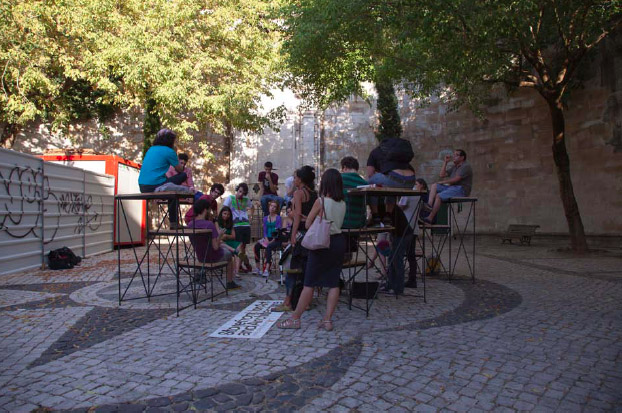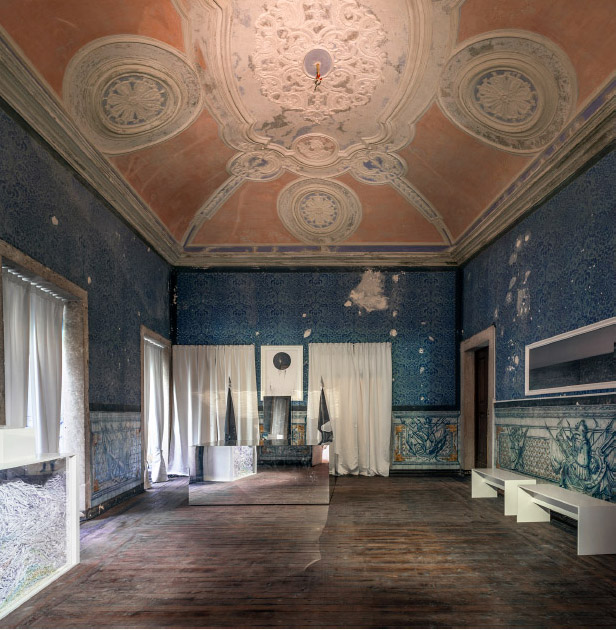Mariana Pestana (PT/UK): ALTERNATIVE POSSIBLE WORLDS
Time: Wednesday 27 May 2015, 5 PM
Venue: Konstfack, Mandelgren (next to Svarta havet)
LM Ericssons väg 14, Stockholm. T-bana: Telefonplan

‘The Universal Declaration of Urban Rights: Urban Parliament’, by Zuloark, ‘The Real
and Other Fictions’, 2013 Lisbon Architecture Triennale. Photo: Luke Hayes
In the sixth lecture within the 2015 Organising Discourse Open Lectures series, Portuguese architect and curator Mariana Pestana looks at how one can use reality and fiction in creating discursive spaces.
Alternative Possible Worlds
“This lecture borrows notions of reality and fiction from literature and translates them to the field of architecture in order to discuss the extent to which spatial design work can generate – even if for a moment in time – alternative, non-actual possible worlds. I will argue that, in depicting versions of the world as it could be, such work creates discursive platforms from where to re-evaluate the world as it is.
Architecture repeats itself through systems, programmes and typologies, which we have became accustomed to considering ‘normal’. Architect and critic Sam Jacob explains this in a stimulating way: as architecture becomes part of the landscape of the everyday, its quotidian banality concedes it reality . As he argues, architecture repeats materiality (bricks or concrete), structural systems (grids, combinations) but also typologies (prisons, city halls) and programmes (living room, bedroom). This constant repetition – besides legitimizing the conditions and ideologies that architecture embodies – is a form of making it seem ‘natural’. The problem that this ‘normality’ entails is, in my opinion, the fact that it perpetuates ideologies and postulates that determine the ways in which architecture is made and used. Disguised as ‘normal’, architecture materializes power structures, choreographs behaviours and relationships of authority that we often forget to question. The temporality that characterizes work operating across architectural design and curatorship opens opportunities to create spaces that break through the ‘normality’ of architecture (and with it the landscape of our everyday) and propose alternatives.
The lecture departs from the concept of ‘alternative possible worlds’ as articulated by the literary critic Marie-Laure Ryan, whose work was introduced to me by Sophia Psarra and analyses a set of relationships between the actual world (which we inhabit) and the non-actual possible worlds contained in texts of literary fiction. I will discuss whether work produced in the cross-disciplinary space between architectural design and curatorship can generate alternative, non-actual possible worlds and what role might users play in such fictional setting. The examples of work that will be presented were produced in the context of an exhibition that I curated for Close, Closer, 2013 Lisbon Architecture Triennale, entitled The Real and Other Fictions. The subject of the exhibition followed the history of its site, a seventeenth-century palace in the centre of Lisbon, and so did the narrative sequence of the show, which was dictated by the spatial configuration of the building. Seven interventions were commissioned to architects, artists and designers, each located in a different room and each responding to a particular historical event that had taken place in the palace. Motivated by the political character of the uses that the palace had in the past, each of the interventions presented a fictional scenario, another possible world, alternative to that outside of the walls of the palace.”

The Nation Room: ‘Embassy of No Land’, by Paulo Moreira and Kiluanji Kia Henda,
‘The Real and Other Fictions’, 2013 Lisbon Architecture Triennale.
Photo: Carlos Azeredo Mesquita
Mariana Pestana is a Portuguese architect and curator. She has a degree in architecture from the University of Porto (FAUP) and a MA in Narrative Environments from Central Saint Martins College of Arts and Design, supported by a grant from Calouste Gulbenkian Foundation. Mariana lives and works in London, where she co-founded the collective The Decorators, with whom she developed curatorial projects and interventions in the public realm. She is doing a PhD at the Bartlett School of Architecture and is a lecturer at Chelsea College of Arts, University of the Arts London. Mariana recently curated the exhibition ‘The Real and Other Fictions’ for ‘Close Closer’, 2013 Lisbon Architecture Triennale and integrated the Official Portuguese Representation at the Venice Architecture Biennale, curated by architect Pedro Campos Costa. She currently works as a curator in the Department of Architecture Design and Digital at the Victoria and Albert Museum.
Download as PDF: Organising Discourse lecture 6
———————————————————————————————————————————————-